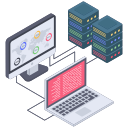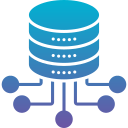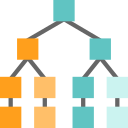Node to Node Delivery at Data Link Layer
Node-to-node delivery at the Data Link Layer is done using MAC addresses and Ethernet frames, and it only works within the same local network (LAN).
Key Concepts
- Node: Any device capable of receiving, sending, or forwarding data (e.g., computers, switches, routers).
- Delivery: The transfer of data frames.
- Data Link Layer: Layer 2 of the OSI model responsible for framing, addressing (using MAC addresses), error detection/correction, and flow control.
What it does
-
Ensures reliable communication between two devices directly connected on the same physical network (e.g., two PCs connected to the same switch or two routers on the same point-to-point link).
-
Encapsulates packets into frames, adds MAC addresses for source and destination, and handles acknowledgment and retransmission if needed (in protocols like HDLC or PPP).
Example:
If Computer A sends a message to Computer B on the same Ethernet network, the data link layer ensures the frame gets from A’s network interface card (NIC) to B’s NIC.
Node to Node Delivery Scenarios
There are 3 main Scenario to discuss in Node to Node delivery
Scenario 1: Only MAC – No Internet
Two devices on the same network (e.g., via Ethernet cable or Bluetooth PAN) communicate directly using MAC addresses only.
No IP configuration or internet is involved; used in simple setups, PXE boot, or local device discovery.
Scenario 2: MAC + IP – No Internet
Devices (like two PCs or a router to a local PC) use IP addresses for identification and MAC addresses for local delivery.
Communication stays within a LAN or between subnets via a router, with no internet access — used in LAN gaming, offline file sharing, or labs.
| How to find IP?
In a no-internet LAN setup, IP addresses can be assigned manually (static IP) by the user or automatically via a local DHCP server like a router. |
Scenario 3: MAC + IP – With Internet
Local MAC addresses deliver the packet to the router, while IP addresses route it across the internet to other routers or servers.
Used in full internet communication like accessing websites or cloud services — think router-to-router or PC-to-server globally.
| How to find IP?
Devices typically obtain IP addresses automatically using DHCP from the router, which may get its own IP from the ISP. |
Summary Table
| Scenario | MAC Used | IP Used | Internet | Example | Notes |
|---|---|---|---|---|---|
| 1. MAC only, no internet | ✅ | ❌ | ❌ | Ethernet cable, Bluetooth PAN | Low-level direct device communication |
| 2. MAC + IP, no internet | ✅ | ✅ | ❌ | PC to router (local), LAN gaming | Local subnet communication via IP |
| 3. MAC + IP, with internet | ✅ | ✅ | ✅ | PC to web server, router to router | End-to-end IP communication via internet |













